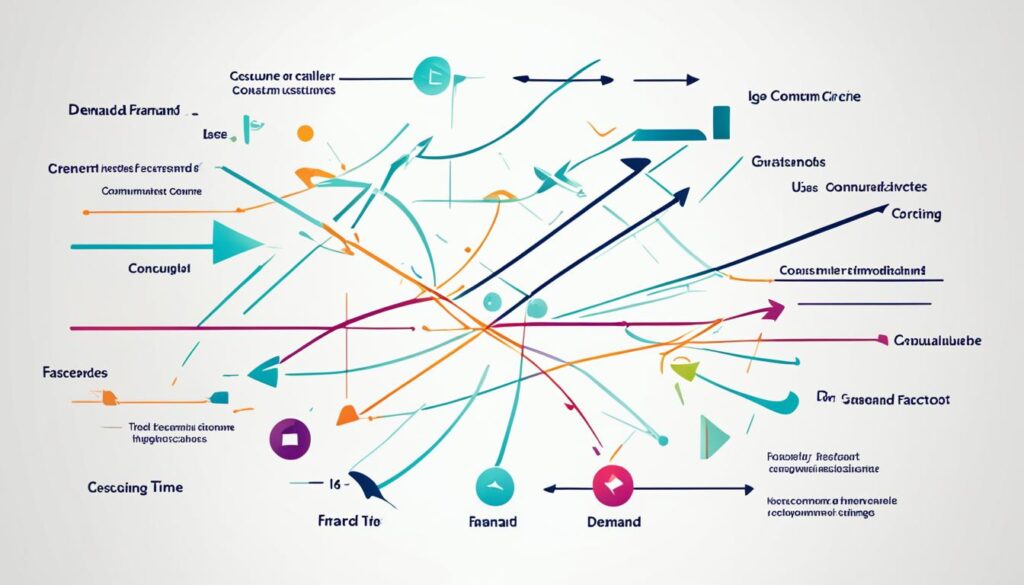Running a consumer packaged goods (CPG) company comes with big challenges. Anticipating consumer goods’ demand is one of them. The demand for these goods is influenced by product price and what customers earn. In this piece, we dive into various market trends and consumer habits. We aim to show how understanding these factors can lead to wise business decisions that foster long-term growth.
Key Takeaways
- Understanding the key demand factors is crucial for CPG companies to set effective pricing policies, identify key value products, and maximize profit margins.
- Factors like price sensitivity, supply and demand, demand forecasting, and demand planning significantly impact consumer demand.
- Analyzing demand elasticity and demand analysis can help CPG brands anticipate consumer needs and create better promotions.
- Staying up-to-date with market trends and consumer behavior is essential for CPG companies to find their place in the highly competitive market.
- Effective demand management strategies can boost sales and market share for CPG brands.
Exploring the Concept of Demand Factor
The law of supply and demand involves two main economic ideas. These ideas show how the cost of something changes its availability and how much people want it. When the price goes up, people buy less, and sellers offer more. If the price lowers, more people want to buy but there’s less available. A graph can show these supply and demand changes. The point where the lines cross shows the best price (equilibrium) for buyers and sellers.
Price Elasticity of Demand
Price elasticity of demand shows how much people change buying because of price changes. It looks at how demand can shift because of the cost. But it’s not just about price. People may buy more or less based on their income or if they find something similar. Companies use this info to set prices. They want to know if their product can adapt to changes in the market.
Factor Influencing Demand
Many things influence how much people want to buy something. This includes if there are similar things to buy, how much they have to spend, how important the item is, and if they have other choices. Companies need to understand these things to choose the right prices. These choices help them stand out and make more money.

Key Demand Factors Impacting Consumer Goods
Price plays the biggest role in demand for a product. A product’s price and how much people want it are closely linked. In general, if a good costs more, fewer people will buy it. Yet, if the price is lower, demand goes up. This is why knowing the right price is crucial for selling consumer goods.
Consumer Tastes and Preferences
What people want affects what they buy. Consumer goods’ demand changes a lot because what people like can shift. There are many reasons for this, some coming from inside the market and some from outside. The consumer packed goods (CPG) industry is always changing. Consumers always want more from their favorite brands. This makes it important to understand your audience. You need to know what each group likes, so you can adjust your product. This can help you better meet their needs.
Consumer Income Levels
How much money people have really influences their spending. People with more money buy more things. They also prefer to buy products of higher quality that cost more. On the flip side, those with less money buy cheaper products or buy fewer things. In times of economic hardship, people spend less. But, when things are good, they tend to spend more.
Availability of Substitutes
There’s always someone else selling what you are. Competitors can draw your customers away if you’re not careful. They can offer a better price, distribution, or similar products. All of this impacts how easy it is for people to choose something else. This, in turn, affects what people buy from you.
Conclusion
Knowing key demand factors is just the start. CPG brands like Procter & Gamble, Unilever, and Nestlé can use this info. They can prepare for what consumers want, make better deals, and stand out in a tough market.
Understanding demand factors helps in several ways. It lets companies make smarter choices, set prices right, and increase their sales. They learn from things like how price changes or what people earn influences what they buy.
The world of consumer goods is always changing. And it’s key to stay ahead. With the right knowledge, CPG companies can improve their products, ads, and general plan to match what consumers need in India and around the world.
Deeply knowing what drives demand helps these brands a lot. It lets them make choices based on data, which keeps them at the top. With this understanding, they open doors to growth, stand out with new ideas, and become more successful in the changing world of consumer goods.
FAQ
What is the law of supply and demand?
The law of supply and demand explains how prices change based on supply and demand. When the price goes up, less is bought but more is available. If the price falls, people buy more but there’s less to sell.
What is demand elasticity?
Demand elasticity shows how much people change their buying because of different prices. Companies use this to set prices that keep customers coming back for more.
What are the key factors that influence demand?
Many things affect how much people want to buy something. Whether they can find something else like it, how much they need it, or how loyal they are to a brand, all plays a part. Time, competition, and good information also matter.
How does the price of a product affect its demand?
The relationship between price and demand is clear. If something costs more, people buy less of it. When it’s cheaper, they buy more. This is crucial for companies making and selling products to understand.
How do consumer tastes and preferences impact demand?
What people like and how much they like it changes how much they buy. Companies need to understand what makes people change their minds about what they want to buy. This helps them plan better.
How does consumer income level affect demand?
Generally, more money means people buy more, especially nicer and more expensive things. But, when the economy is bad, what people want to buy might change. This affects when and how much they spend.
How do competitors affect demand?
Competition always affects what and how much people buy. Prices, where you find products, and other options can change what customers choose. Keeping an eye on what your rivals are doing helps keep your business strong.

